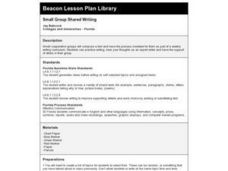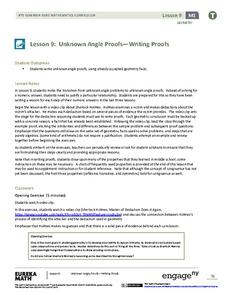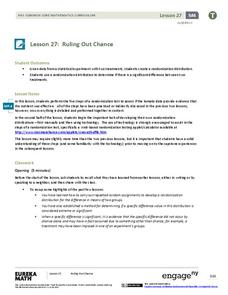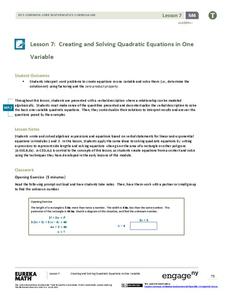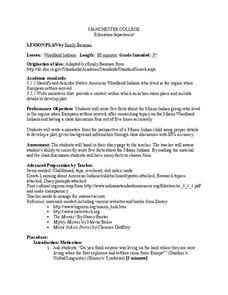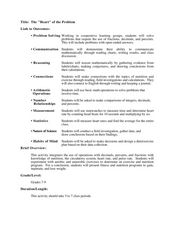Curated OER
Geography: Floods on Topical Budget
Students explore, examine and study the causes and effects of flooding to assess floods in the past to understand floods in the present. They view a variety of video clips and discuss them and then divide up into small groups to plan...
Curated OER
Small Group Shared Writing
Learners discuss elements of effective writing in small groups. They work together to critique individual and group writing focusing on including supporting details.
Curated OER
The Importance of Groups
Students discuss why groups are important and why humans go through daily life performing group activities.
EngageNY
Modeling an Invasive Species Population
Context makes everything better! Groups use real data to create models and make predictions. Classmates compare an exponential model to a linear model, then consider the real-life implications.
EngageNY
Statements of Order in the Real World
Positive and negative numbers are all around us. Groups read short story contexts and identify a rational number that represents the values in the context. They order the rational numbers and interpret statements of inequality.
EngageNY
Modeling a Context from a Verbal Description (part 2)
I got a different answer, are they both correct? While working through modeling problems interpreting graphs, the question of precision is brought into the discussion. Problems are presented in which a precise answer is needed and others...
EngageNY
Unknown Angle Proofs—Writing Proofs
What do Sherlock Holmes and geometry have in common? Why, it is a matter of deductive reasoning as the class learns how to justify each step of a problem. Pupils then present a known fact to ensure that their decision is correct.
EngageNY
Classification of Solutions
Is there one, none, or more? Through discussion or activity, scholars find the properties of an equation that will determine the number of solutions. They then use the properties discovered to figure out the number of solutions for a...
EngageNY
Analyzing a Data Set
Through discussions and journaling, classmates determine methods to associate types of functions with data presented in a table. Small groups then work with examples and exercises to refine their methods and find functions that work to...
EngageNY
Even and Odd Numbers
Even or not, here I come. Groups investigate the parity of products and sums of whole numbers in the 17th lesson in a series of 21. Using dots to represent numbers, they develop a pattern for the products of two even numbers; two odd...
Beauty and Joy of Computing
Search Engines
Which search engine is best? The last lab in a unit of five leads the class to investigate search engines. Working in groups, individuals read and discuss articles related to searching the Internet. Pupils develop suggestions that would...
EngageNY
Read Expressions in Which Letters Stand for Numbers III
Those key operation words sure come in handy. Groups continue their work with converting between different notations for algebraic expressions. They work in stations to write the symbolic form for given verbal phrases. This is the 17th...
EngageNY
General Pyramids and Cones and Their Cross-Sections
Are pyramids and cones similar in definition to prisms and cylinders? By examining the definitions, pupils determine that pyramids and cones are subsets of general cones. Working in groups, they continue to investigate the relationships...
EngageNY
Comparing Rational Expressions
Introduce a new type of function through discovery. Math learners build an understanding of rational expressions by creating tables and graphing the result.
EngageNY
Ruling Out Chance (part 3)
Pupils analyze group data to identify significant differences. They use simulation to create their own random assignment data for comparison.
EngageNY
Creating and Solving Quadratic Equations in One Variable
Give your classes practice at modeling using quadratic models with a resource that uses area and integer problems to allow individuals to create second degree polynomials. Young mathematicians solve equations using factoring and then...
ProCon
Should Recreational Marijuana Be Legal?
Almost 600,000 Americans are arrested each year for marijuana possession. Pupils decide if marijuana should be legalized for recreational use after reading state-by-state laws and the top pro and con arguments. The resource also includes...
Curated OER
Political Race
Learners explore political topics and issues that often involve discussions of race or ethnicity. They develop campaign speeches voicing their stances on their assigned topics and explore how their racial and/ or ethnic backgrounds shape...
Curated OER
Island of the Blue Dolphins Jigsaw
Fourth graders research three topics from the book, either Village Life, Sea Life, or San Nicholas Island. They research independently and meet in a jigsaw format to share what they learned. As group they create a poster for class...
Curated OER
Producing a skit for the morning announcements
Students produce a skit to appear on their morning announcement that is in lined with their franchise topic. In this producing lesson plan, students produce a 2 minute skit including originating, scripting, editing, directing, and...
Curated OER
Woodland Indians
Third graders research Woodland Indians. In this Woodland Indian lesson, 3rd graders have a classroom discussion and write facts about the Miami Indian group. They write a narrative from the perspective of an Indian child.
Curated OER
Information Extra
Learners create a paragraph about a subject of their chosing that is informative. In this paragraph writing lesson plan, students use graphic organizers and work together in groups to create a full, organized paragraph. This lesson plan...
Curated OER
The "Heart" of the Problem
Students create an exercise and nutrition program. In this interdisciplinary lesson, students use calculations of exercises plus their corresponding effects on the body and nutritional values of food to derive a health plan. Students...
Curated OER
Getting Adults and Children to Talk
Students engage in activities to practice their speaking skills. They role play, tell stories, use puppets and props, play games and solve puzzles. They sing songs and use rhymes to practice repetition. They read and respond to articles...



